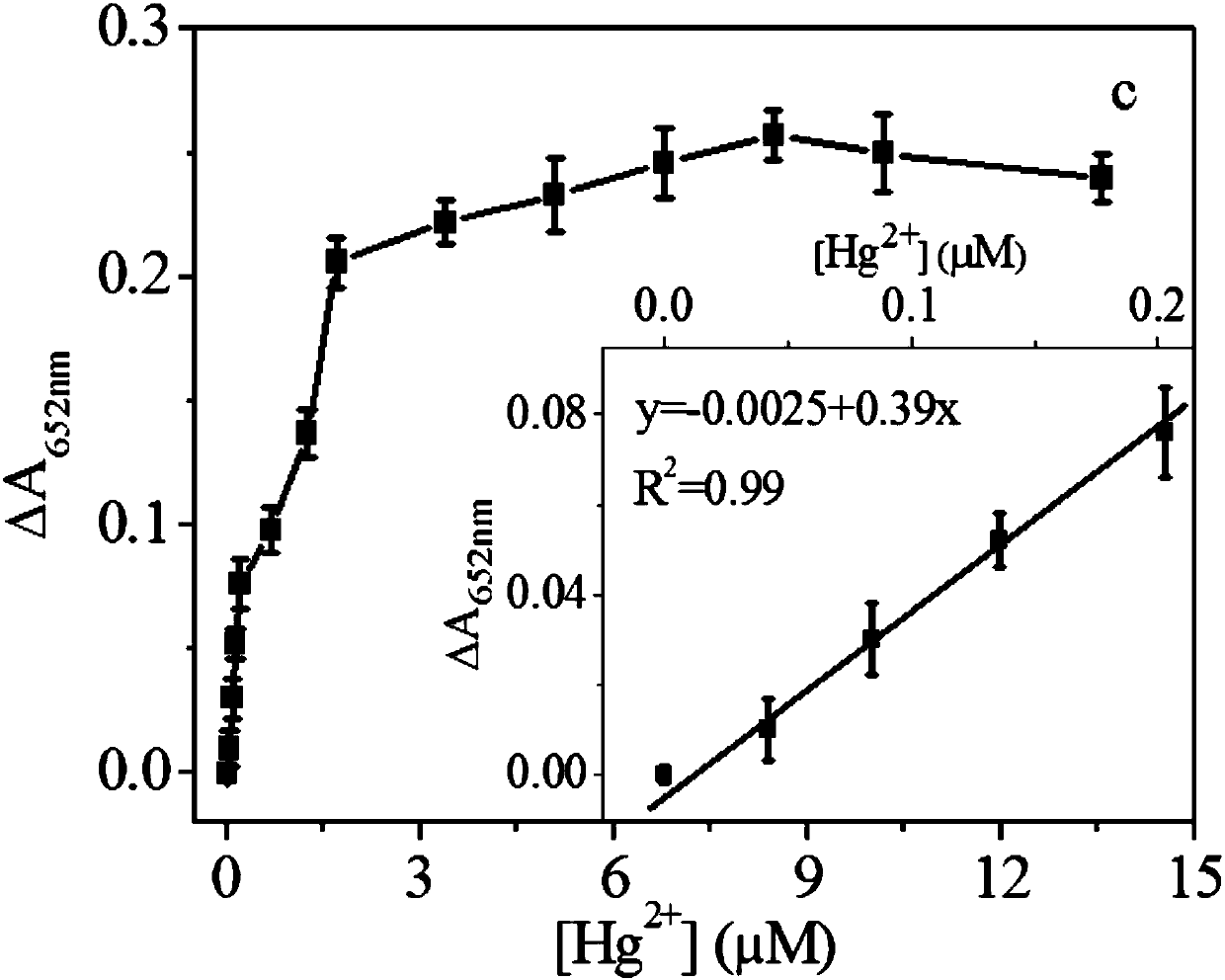Method for detecting mercury ions by chitosan-gold nanoparticles
A gold nanoparticle and chitosan technology, applied in the field of analysis, can solve the problems of complex sample pretreatment, expensive equipment, time-consuming, etc., and achieve the effects of rapid detection, short time-consuming, and easy operation
- Summary
- Abstract
- Description
- Claims
- Application Information
AI Technical Summary
Problems solved by technology
Method used
Image
Examples
Embodiment 1
[0056] The chitosan-gold nanoparticles provided by the present embodiment adopt the following steps to make:
[0057] 1mL 3mmol / L of HAuCl 4 and 2 mL of 0.003 g / mL chitosan solution were added to 10 mL of deionized water. Then, the mixture was heated to boiling and continued to reflux and stir for 30 min. After the reaction, cool to room temperature.
[0058] Hg 2+ The detection of: first, prepare 14 different concentrations of Hg 2+ solution. Hg per serving 2+ The volume of the solutions is 100uL, and the concentrations are 0, 0.396, 0.792, 1.386, 1.98, 6.93, 1.2, 11.88, 33.66, 49.5, 67.32, 84.15, 100.98 and 134.64umol / L.
[0059] to each Hg 2+ 160 uL of chitosan-gold nanoparticles prepared above were respectively added into the solution, and 14 parts of the first mixed solution were obtained after mixing.
[0060] After the above 14 parts of the first mixed solution were placed at 25°C for 5 minutes, 330 uL of acetic acid-sodium acetate buffer solution with a concent...
Embodiment 2
[0062] The chitosan-gold nanoparticles provided by the present embodiment adopt the following steps to make:
[0063] 1mL 2mmol / L of HAuCl 4 and 2 mL of 0.002 g / mL chitosan solution were added to 10 mL of deionized water. Then, the mixture was heated to boiling and continued to reflux and stir for 20 min. After the reaction, cool to room temperature.
[0064] Hg 2+ The detection of: first, prepare 14 different concentrations of Hg 2+ solution. Hg per serving 2+ The volume of the solutions is 100uL, and the concentrations are 0, 0.396, 0.792, 1.386, 1.98, 6.93, 1.2, 11.88, 33.66, 49.5, 67.32, 84.15, 100.98 and 134.64umol / L.
[0065] to each Hg 2+ 160 uL of chitosan-gold nanoparticles prepared above were respectively added into the solution, and 14 parts of the first mixed solution were obtained after mixing.
[0066] After the above 14 parts of the first mixed solution were placed at 25°C for 5 minutes, 330 uL of acetic acid-sodium acetate buffer solution with a concent...
Embodiment 3
[0068] The chitosan-gold nanoparticles provided by the present embodiment adopt the following steps to make:
[0069] 1mL 4mmol / L of HAuCl 4 and 2 mL of 0.004 g / mL chitosan solution were added to 10 mL of deionized water. Then, the mixture was heated to boiling and continued to reflux and stir for 40 min. After the reaction, cool to room temperature.
[0070] Hg 2+ The detection of: first, prepare 14 different concentrations of Hg 2+ solution. Hg per serving 2+ The volume of the solutions is 100uL, and the concentrations are 0, 0.396, 0.792, 1.386, 1.98, 6.93, 1.2, 11.88, 33.66, 49.5, 67.32, 84.15, 100.98 and 134.64umol / L.
[0071] to each Hg 2+ 160 uL of chitosan-gold nanoparticles prepared above were respectively added into the solution, and 14 parts of the first mixed solution were obtained after mixing.
[0072] After the above 14 parts of the first mixed solution were placed at 25°C for 5 minutes, 330 uL of acetic acid-sodium acetate buffer solution with a concent...
PUM
| Property | Measurement | Unit |
|---|---|---|
| Concentration | aaaaa | aaaaa |
| Concentration | aaaaa | aaaaa |
| Concentration | aaaaa | aaaaa |
Abstract
Description
Claims
Application Information
 Login to View More
Login to View More - R&D
- Intellectual Property
- Life Sciences
- Materials
- Tech Scout
- Unparalleled Data Quality
- Higher Quality Content
- 60% Fewer Hallucinations
Browse by: Latest US Patents, China's latest patents, Technical Efficacy Thesaurus, Application Domain, Technology Topic, Popular Technical Reports.
© 2025 PatSnap. All rights reserved.Legal|Privacy policy|Modern Slavery Act Transparency Statement|Sitemap|About US| Contact US: help@patsnap.com



